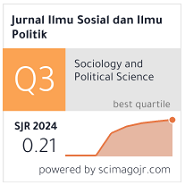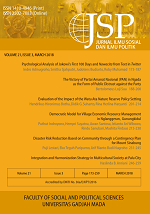The Unemployment Rate Amid the COVID-19 Pandemic: Propose the Best Practices Policy to Maintain Labor Market Stability
Nazaruddin Malik(1), Muhammad Sri Wahyudi Suliswanto(2*), Mochamad Rofik(3)
(1) Department of Development Economics, Faculty of Economics and Business, Universitas Muhammadiyah Malang, Indonesia
(2) Department of Development Economics, Faculty of Economics and Business, Universitas Muhammadiyah Malang, Indonesia
(3) Center for Economics, Business and Entrepreneurship Development, Faculty of Economics and Business, Universitas Muhammadiyah Malang, Indonesia
(*) Corresponding Author
Abstract
This study analyzes the impact of the shocks caused by the COVID-19 pandemic on the labor market. The research is vital for expanding the literature about maintaining the unemployment rate amid crisis, ultimately reducing unnecessary social costs. The quantitative approach in this study uses a Granger causality test to understand the effect of the shock caused by the COVID-19 pandemic on unemployment. Meanwhile, the qualitative approach in this study uses literature related to economic growth, crisis management, and unemployment. Granger causality tests show that economic slowdown hurts the unemployment rate. Based on discussion and synthesis from works of literature, this paper recommends some of the policies to maintain growth and prevent a more severe collapse in the labor market; the government needs to sustain aggregate demand and supply. Also, ensure the supply chain runs well amid various restrictions. Besides, this paper also proposes that the government maximizes alternative budget resources. Meanwhile, strengthening the labor system and developing health and food security industries must be a priority policy amid-post the pandemic.
Keywords
Full Text:
PDFReferences
Akwara, A. F., Akwara, Ngozi F, Enwuchola, John, Adekunle, Udaw, & Joseph E. (2013). Unemployment and Poverty: Implications for National Security and Good Governance in Nigeria. International Journal of Public Administration and Management Research.
Ashwin, S., & Lytkina, T. (2004). Men in Crisis in Russia: The Role of Domestic Marginalization. In Gender and Society. https://doi.org/10.1177/0891243203261263
Asian Development Bank. (2016). Analysis of Trends and Challenges in the Indonesian Labor Market. Asian Development Bank (ADB) Paper on Indonesia. https://doi. org/10.1016/J.RCP.2015.08.004
Azizah, R. N., Zauhar, S., & Soeaidy, M. S. (2015). Pemberdayaan Masyarakat Dalam Mengurangi Angka Pengangguran di Kabupaten Sampang. Wacana, Jurnal Sosial Dan Humaniora, 18(03), 203–2012. https:// doi.org/10.21776/ub.wacana.2017.018.03.7
Barlevy, G. (2011). Evaluating the Role of L abor Market Mismatch in Rising Unemployment. Economic Perspectives, 3, 82–96.
Charles, K. K., Hurst, E., & Notowidigdo, M. J. (2013). Equilibrium nemployment and Capital Intensity under Product and Labor Market Imperfections. October, 7180.
Chuma, A. H. (2002). Employment adjustments in Japanese firms during the current crisis. Industrial Relations, 41(4), 653–682. https:// doi.org/10.1111/1468-232X.00268
Coibion, O., Gorodnichenko, Y., & Weber, M. (2020). Labor Markets During the COVID-19 Crisis: A Preliminary View. SSRN Electronic Journal. https://doi. org/10.2139/ssrn.3574736
Cramer, C. (2010). Unemployment and Participation in Violence. World Development Report 2011.
Cynamon, B. Z., Fazzari, S. M., & Setterfield, M . (2012). U nd ers tand ing the great recession. After the Great Recessi on: The Struggle for Economic Recovery and Growth, 9781107015(1), 3–30. https://doi. org/10.1017/CBO9781139059589.004
Duygan-Bump, B., Levkov, A., & Montoriol- Garriga, J. (2015). Financing constraints and unemployment: Evidence from the Great Recession. Journal of Monetary Economics , 75 , 89–105. https ://d o i. org/10.1016/j.jmoneco.2014.12.011
Elsby, M. W. L., Hobijn, B., & Sahin, A. (2010). The labor market in the great recession. Brookings Papers on Economic Activity. https://doi.org/10.1353/eca.2010.0001
Figura, A., & Barnichon, R. (2014). The Effects of Unemployment Benefits on Unemployment and Labor Force Participation: Evidence from 35 Years of Benefits Extensions. Finance and Economics Discussion Series. https://doi. org/10.17016/feds.2014.065
Fort, T. C., Haltiwanger, J., Jarmin, R. S., & Miranda, J. (2013). How firms respond to business cycles: The role of firm age and firm size. IMF Economic Review. https:// doi.org/10.1057/imfer.2013.15
Furlanetto, F., & Groshenny, N. (2014). Mismatch shocks and unemployment during the great recession. Journal of Applied Econometrics, 21(August 2012), 1–21. https://doi.org/10.1002/jae
Gregg Paul, & Wadsworth Jonathan. (2010). Employment in the 2008–2009 recession. Economic and Labour Market Review , 4(8). https://link.springer.com/content/pdf/10.1057%2Felmr.2010.111.pdf.
Hijzen, A., Kambayashi, R., Teruyama, H., & Genda, Y. (2015). The Japanese labour market during the global financial crisis and the role of non-standard work: A micro perspective. Journal of the Japanese and International Economies, 38(9391), 260–281. https://doi.org/10.1016/j.jjie.2015.09.003
Jagannathan, R., Kapoor, M., & Schaumburg, E. (2013). Causes of the great recession of 2007-2009: The financial crisis was the symptom not the disease! Journal of Financial Intermediation. https://doi. org/10.1016/j.jfi.2012.06.002
Lee, A., & Cho, J. (2016). The impact of epidemics on labor market: identifying victims of the Middle East Respiratory Syndrome in the Korean labor market. International Journal for Equity in Health, 15(1), 1–15. https://doi. org/10.1186/s12939-016-0483-9
Lee, G. O. M ., & Warner, M . (2005). Epidemics, labour markets and unemployment: The impact of SARS on human resource management in the Hong Kong service sector. International Journal of Human Resource Management, 16(5), 752–771. https://doi. org/10.1080/09585190500083202
Longstaff, F. A. (2010). The subprime credit crisis and contagion in financial markets. Journal of Financial Economics. https://doi. org/10.1016/j.jfineco.2010.01.002
Mandel, C., & Liebens, P. (2019). The Relationship between GDP and Unemployment Rate in the U.S. International Journal of Business and Social Science, 10(4), 17–24. https://doi. org/10.30845/ijbss.v10n4p3
Manoppo, V. (2015). Utang luar Negeri Indonesia (Perspketif Politik). 3(2), 54–67. http:// repositorio.unan.edu.ni/2986/1/5624.pdf
Matousek, R., Papadamou, S., Šević, A., & Tzeremes, N. G. (2019). The effectiveness of quantitative easing: Evidence from Japan. Journal of International Money and Finance. https://doi.org/10.1016/j. jimonfin.2019.102068
O’Campo, P., Molnar, A., Ng, E., Renahy, E., Mitchell, C., Shankardass, K., St. John, A., Bambra, C., & Muntaner, C. (2015). Social welfare matters: A realist review of when, how, and why unemployment insurance impacts poverty and health. Social Science and Medicine. https://doi.org/10.1016/j. socscimed.2015.03.025
Okoli, C. (2015). A guide to conducting a st andalone sy st ematic lit erat ure review. Communications of the Association for Information Systems . https://d oi. org/10.17705/1cais.03743
Padrón, B. R., & Burger, K. (2015). Diversification and Labor Market Effects of the Mexican Coffee Crisis. World Development. https:// doi.org/10.1016/j.worlddev.2014.11.005
Quon, T. K., Zeghal, D., & Maingot, M. (2012). Enterprise Risk Management and Firm Performance. Procedia - Social and Behavioral Sciences . https://doi. org/10.1016/j.sbspro.2012.09.042
Ramadhita, R. (2012). Optimalisasi Peran Lembaga Amil Zakat Dalam Kehidupan Sosial. Jurisdictie, 24–34. https://doi. org/10.18860/j.v0i0.2182
Saint-Paul, G. (2005). The Political Consequences o f U nem plo ym ent. SSRN Electronic Journal, May, 1–46. https://doi.org/10.2139/ ssrn.145753
Schaal, E. (2012). Uncertainty, Productivity and Unemploy ment in the Great Recession. Federal Reserve Bank of Minneapolis, Mimeo, 1–59. http://www. frbatlanta.org/documents/news/ conferences/12employment_schaal.pdf
Schmitz, H. (2011). Why are the unemployed in wo rs e health? The causal effect of unemployment on health. Labour E c onom ic s. https://doi.org/10.1016/j. labeco.2010.08.005
Sedláček, P. (2014). Match efficiency and firms’ hiring standards. Journal of Monetary Economics, 62(1), 123–133. https://doi. org/10.1016/j.jmoneco.2013.10.001
Vu, A. N. (2020). On the impact of quantitative easing on credit standards and systemic risk: The Japanese experience. Economics Letters. https://doi.org/10.1016/j. econlet.2019.07.005
Weißer, T., Saßmannshausen, T., Ohrndorf, D., Burggräf, P., & Wagner, J. (2020). A clustering approach for topic filtering within systematic literature reviews. MethodsX . https://doi.org/10.1016/j. mex.2020.100831
Xiao, Y., & Watson, M. (2019). Guidance on Conducting a Systematic Literature Re v iew. In Journal of Planning Education and Research . https://doi.org/10.1177/0739456X17723971
Article Metrics
Refbacks
- There are currently no refbacks.
Copyright (c) 2021 Jurnal Ilmu Sosial dan Ilmu Politik

This work is licensed under a Creative Commons Attribution-NonCommercial-NoDerivatives 4.0 International License.






















